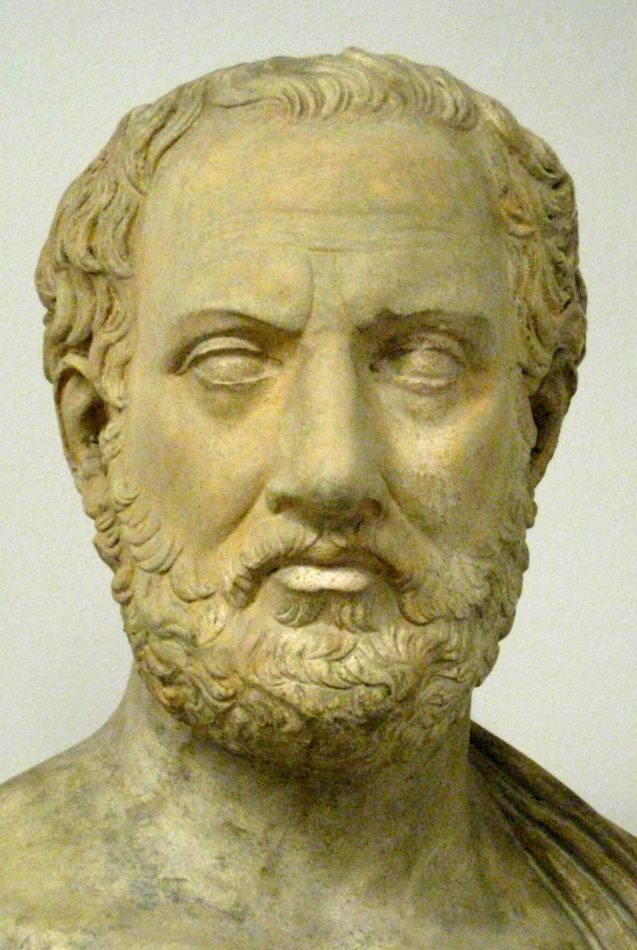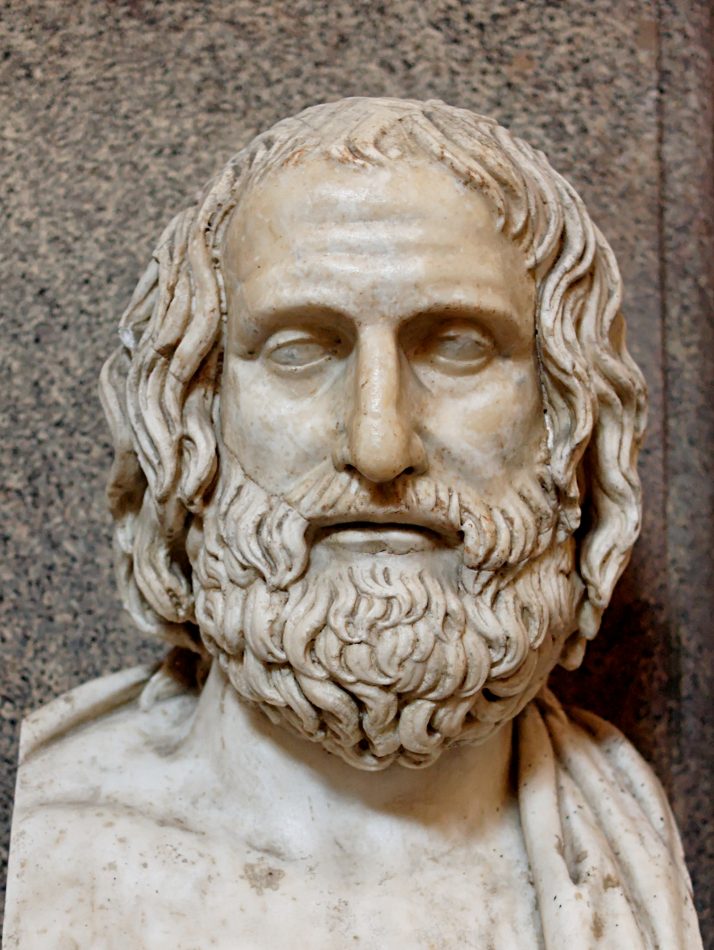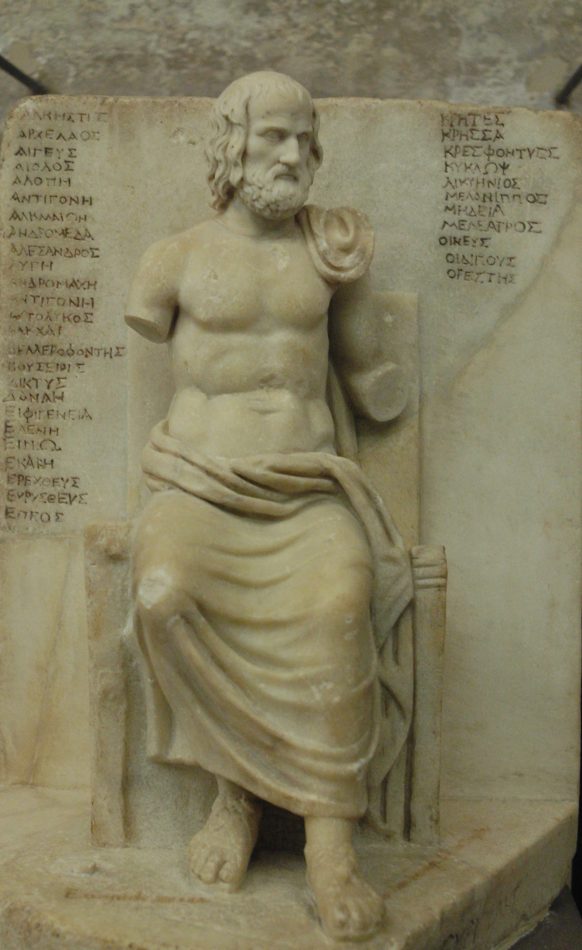Euripides and the battle of Delium
In our accounts of the battle of Delium, or Delion, fought between Athens and Thebes in winter 424 BC, both Thucydides (4.93-96) and Diodorus (12.70.1-5) have been criticized for including elements from the Suppliants, or Supplices, of Euripides. These criticisms may, however, have got things around the wrong way – Euripides may have included elements of the actual battle in his play.
The idea that Greek tragedy should be viewed through a contemporary filter has gone out of favour recently but that pendulum has swung so far that now, some would argue that there was almost no contemporary resonance at all in Greek tragedy. As Antony Keen pointed out “a play need not be a complete allegory to carry contemporary resonances, and that the differences between the action of the play and contemporary reality can be illuminating for Athenian public ideology” (http://didaskalia.net/issues/vol4no1/keen.html). Tragedy can still be used for some details of the experience of ancient Greek battle – the best example being Aeschylus’ Persae (produced in 472) written by a man who was a participant at Marathon and probably Salamis as well. Euripides’ Supplices presents compelling arguments that we should not dismiss the idea of contemporary relevance later in the century either.
The Battle of Delium
In 424 BC, the Athenian generals Demosthenes and Hippocrates were meddling in Boeotian affairs, cooperating with a group of democrats who wished to transform their governments (and become Athenian rather than Spartan allies). The plan was that the Athenians would occupy and fortify Delium, a sanctuary of Apollo, in the territory of Tangara and coordinate other, simultaneous territory seizures (Thucydides 4.76.1-5) to split any Boeotian response. When these occurred, in the early winter (Thucydides 4.89.1) of 424, the Boeotians gathered in Tangara and were convinced by Pagondas (chief of the Boeotarchs) to attack the Athenians at Delium. Hippocrates levied the entire available forces of Athens: citizens, resident aliens and foreigners (4.90.1) which amounted to 7,000 hoplites. This force fortified a site near Delium but had begun to withdraw back to Athens when Pagondas, general of the Thebans, led his army against them. Thucydides gives detailed dispositions for both armies (4.93.3-94.1). The Thebans had 7,000 hoplites, 10,000 light troops, 500 peltasts and 1,000 cavalry. Diodorus’ numbers (12.69.3), a “little less than 20,000 infantry and about 1,000 cavalry,” correspond relatively closely to Thucydides’ numbers (which add up to 17,500 infantry and 1,000 cavalry). According to Thucydides, the Thebans were on the right wing, the Haliartians, Coroneans and Copaeans were in the centre and the left consisted of the men of Thespiae, Tangara and Orchomenus. Each wing consisted of cavalry and light-armed troops. Diodorus also tells us (in less detail), that the Thebans occupied the right and the Orchomenians the left. Thucydides tells us that the Thebans were marshalled twenty-five shields deep (the usual depth was between eight and twelve). The Athenian line consisted of their 7,000 hoplites, but most of the light armed troops were not present, already having started back for Athens. Athenian cavalry numbers are not mentioned (300 had been left at Delium) but were probably less than 1,000 (the plague of 427/6 had claimed 300 of them). The Athenians drew up eight ranks deep (so approximately 875 men across) with the cavalry on either wing.
The Boeotians were deployed on a hill and charged towards the Athenians. The Athenians charged towards the Boeotian advance and the two sides met at a run (Thucydides 4.96.1). The extremities of either line did not come into contact, hampered by the terrain, but the hoplite phalanxes of each side were engaged in heavy fighting. The Boeotian left, as far as the centre, was bested by the Athenians opposite them. The Boeotian right wing, however, where the Thebans were, pushed the Athenians back. Seeing this, Pagondas also sent two squadrons of cavalry (possibly 200 men) around the hill to aid the Boeotian left. According to Thucydides (4.96.6):
“When these suddenly appeared, the victorious wing of the Athenians, thinking that another army was coming on, was thrown into a panic. At this time, owing to this [cavalry] manoeuvre and to the Thebans following them up and breaking their line, a rout of the whole Athenian army ensued.”
Diodorus (12.70.1-4) offers a different account of the battle (which is not wholly reconcilable with Thucydides’ account although it is less problematic than some would make it). Diodorus does not include the depth of the Theban line or the cavalry reinforcements sent around the hill by Pagondas, but he does include a front rank of the “whole army” being 300 “charioteers and footmen” (12.70.1). A 300-man wide formation, 25 shields deep (as per Thucydides) would give 7,500 hoplites – almost the number of Theban hoplites in Thucydides. In Diodorus’ account, the Athenian cavalry first defeated and chased off the Boeotian cavalry (not hampered by the swollen torrents of Thucydides). Then, as in Thucydides’ account, the Athenian right wing was victorious, but the left was pushed back and put to flight by the Thebans. The victorious Theban wing then turned away from pursuit of the defeated Athenians and attacked the victorious Athenian right wing causing the Athenian right wing to also flee.
Thucydides continues (4.96.7-8) that some of the Athenians “hastened to Delium and the sea, others toward Oropus, others to Mt. Parnes, others wherever each had hope of safety.” The Boeotians, especially their cavalry and the Locrian cavalry who had just arrived, followed the Athenians and slew them as they fled, including light-armed troops who had not moved fast enough away from Delium. Earlier (4.93.1) Thucydides recorded that it was already late in the day when Pagodas led the Boeotians into battle and so night saved many of the fleeing Athenians. Diodorus (12.70.4) makes night saving the Athenians from greater losses explicit: “if night had not intervened, most of the Athenians would have perished, for it broke the drive of the pursuers and brought safety to those in flight.” The following day, Athenian troops from Oropus and Delium left for Athens by sea although a garrison was left at Delium. Again, Diodorus offers a slightly different picture stating that the Athenians fled to Oropus and Delium and some towards the sea and the Athenian ships (12.70.4). Thucydides (4.101.2) gives the casualty numbers as little more than 500 Boeotians and a little less than 1,000 Athenians including the general Hippocrates (as well as a great number of light-armed troops and baggage carriers). Diodorus (12.70.4) numbers Athenian casualties at “many times” the 500 lost by the Boeotians.
Sources of the Sources
Diodorus’ account of the battle Delium has been criticized and rejected by some commentators; his “charioteers and footmen” (eniochoi kai parabatai) in the front line of the Boeotian army in particular, especially by Gomme and Pritchett (Gomme 1956: 568; Pritchett 1992: 222). Some have argued that Diodorus wants there to be actual chariots in a hoplite battle in 424 (Jeffrey 1988: 360). Euripides has chariots in his mythological battle who begin the fight (lines 661-663, 666-667, 673-685) and this criticism has gone far enough to suggest that Diodorus’ account of the battle incorporated ahistorical elements from Euripides’ play (Toher 2001: 1878-182). Rather than this, as I argued in Ancient Warfare 14.2 (‘The 300 Thebans’: 50-55), the “charioteers and footmen” is a term referring to the Theban and Boeotian elite units of 300 members stretching back at least as far as Plataea (Herodotus 9.67), probably earlier and which would ultimately evolve into the Theban Sacred Band in the 4th century.

Similarities between Euripides’ play and Thucydides’ account of Delium have also been noted. The cavalry in both battles was drawn up on the wings (Thucydides 4.94.1, lines 660-661). Just like in Thucydides’ account of Delium (4.96.3-4), the left wing of the Athenians was driven back while the right wing was victorious (lines 704-706). It is entirely possible that Euripides’ imagery in Suppliants directly appealed to the recent experiences of the Athenians fighting the Thebans at Delium just as much as to a mythological battle between Theseus and Creon.
Euripides Suppliants
Euripides’ play Iketides, Suppliants (also known as Suppliant Women, or by its Latin title Supplices to differentiate it from Aeschylus’ play of the same name) was produced in 423, the year after the battle of Delium. In that year, several comedies referenced the conduct of Athenians in the battle, especially Socrates’ bravery, but also shows of cowardice. We have references to Socrates' conduct in Aristophanes’ Clouds, but also Ameipsias’ Connus and Eupolis (F. 386), and cowardice (Cleonymus and Peisander are singled out) in Clouds, Wasps, and Birds, Eupolis (F. 35) Aristomenes (F. 15), Phrynichus (F. 21 A and B), and Ameipsias (F. 16). This is of interest since the entire manpower of Athens was routed, 7,000 hoplites, so no one, with the exception of Socrates, seems to have behaved with courage (Plato Symposium 220D-221C, Laches 181 A-B). Athens lost 1,000 hoplites and so the battle was much on the minds of contemporary Athenians.

The battle of Delium seems to have had an influence on Euripides’ play, especially in the unusually long and detailed Messenger speech (lines 650-725) which recounts a battle between Athenians and Thebans. Similarities between Euripides’ play and both Diodorus and Thucydides’ account of Delium have been noted, but it may be that these analyses have got things the wrong way around. Rather than historians using Euripides to colour their battle accounts, the reason for the similarities between the historical accounts and Euripides may be because the playwright used the experiences of the recent battle to flavour his mythical tragedy. It is possible that the battle itself produced echoes in the play and that this was deliberately done by Euripides in an unusual speech. Several other aspects of the play would have also resonated especially with the Athenian audience the year after their catastrophic defeat at Delium.
That is not to say that the whole play is an allegory of Delium (in the play it is an Athenian victory after all). We should remember too that Euripides (born in c.480 on Salamis) was still eligible to serve in Athens’ forces (at the age of approximately 56) and may have served at Delium himself. Thucydides tells us that the Athenian forces were a levy of everyone available (4.90.1). Euripides was famously a recluse, living in a cave on Salamis, but we do not know how he negotiated away his civic duty, if indeed he did. We certainly have Salamanian hoplites serving in Athens’ armed forces (such as those depicted on the funerary stelae of Chairedemos and Lykeas who died in the Peloponnesian War c.420, now in the Archaeological Museum of Pireus (Inv. 385)). There is no evidence, however, of any civic duty performed by Euripides. Sophocles, by contrast, born in c.497 (and therefore in his seventies in 424) was probably not called upon at Athens although he may fall into the ‘oldest’ category who could still be called upon to perform some military service, especially in times of extreme crisis (Thucydides 1.105.3-4, 2.13.6-7).
The activities of Socrates and Euripides were closely linked by contemporaries. The comic poet Teleclides (F 41 and 42) stated that the two were bolted together and even Aristophanes linked them in Frogs (1490-99), the accusation being that Socrates co-authored some of Euripides’ plays. It might be possible that, just as comedies in 423 referred to Socrates’ conduct at Delium, Euripides’ play reminded the audience of how Athenians should have behaved (and how Socrates did). We might be pushing things too far to see a reference to Socrates’ bravery in the final lines of the Messenger’s speech (726-727): “This then is the kind of general one should choose, a man who is brave in the hour of danger,” but Socrates’ behaviour was well known as the single instance of bravery on the day of Delium. There may be another Socratic link in Adrastus’ line (914-917) that courage can be taught and that mothers should raise your children well, the subject of the Laches dialogue featuring Socrates (usually argued to be set around 420 BC).
Euripides’ play deals with the refusal of the Thebans to surrender the bodies of the seven heroes of Argos for burial. This immediately echoed the refusal of the Boeotians to allow the Athenians to bury their dead after Delium (Thucydides 4.98.8). Another factor is the constant references to the bodies of the seven and the chorus who represented their seven mothers. This may have had a connection with the seven thousand Athenians hoplites who fought in the battle (Thucydides 4.93.3-94.1). We get later references in the play to the “seven famous companies” (line 755 - lochoi is used in the text) which might also refer to the 7,000 hoplites from Athens. The lamenting of king Adrastus of Argos (that it was better for him to have died with the seven – lines 769, 821) might reference similar feelings at Athens among its fathers and mothers in 424. Many of the chorus lines of the seven mothers would also have been especially relevant in post-Delium Athens (see lines 778-797). One factor which makes Euripides’ play particularly interesting is that the tragic chorus of fifteen members was expected to represent only seven Argive mothers. Various solutions have been suggested (the chorus also played the parts of attendants and later the seven sons), none of which divide well into fifteen. If fifteen chorus members represented the seven mothers of the fallen, this too was possibly a visual reminder of the additional Athenian mothers (1,000 of them) who had lost sons at Delium.

In the Messenger’s speech in Suppliants, Euripides recounts the mythological victory of the Athenians led by Theseus against the Thebans led by Creon. An Athenian victory against the Thebans immediately contrasted with the battle of Delium in 424. The end of the play (lines 1213-1226) has Athena promising the children of the Argive champions vengeance on the city of Thebes. One cannot think of a more fitting end to a play written the year after Athens’ devastating defeat at Delium at the hands of the Thebans.
Further Reading
A.M. Bowie ‘Tragic filters for history: Euripides Supplices and Sophocles’ Philoctetes’ in C. Pelling (ed.) Greek Tragedy and the Historian (Oxford, 1997), pp. 39-62.
A.W. Gomme A Historical Commentary on Thucydides, Volume 3, Books IV-V.24 (Oxford, 1956).
L.H. Jeffrey ‘Greece before the Persian Invasion,’ Persia, Greece and the Western Mediterranean c.525 to 479, The Cambridge Ancient History IV, 2nd Edition (1988), pp. 347-367.
Antony Keen review of Pelling http://didaskalia.net/issues/vol4no1/keen.html.
John Lazenby ‘The Killing Zone’, in V.D. Hanson (ed.) Hoplites. The Classical Greek Battle Experience (London and New York, 1991), pp. 87-109.
- Toher ‘Diodorus on Delion and Euripides’ Supplices’ Classical Quarterly 51 (2001), pp. 178-182.
W.K. Pritchet Greek State at War Volume II (Berkeley, Los Angeles, 1992).
